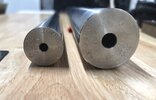Trey Veston
Member
On a couple of my YouTube videos, due to the bag rest and angle of the camera, it looks like I am resting the barrel of my rifles on the sandbag, which viewers are quick to point out will ruin accuracy and cause stringing. I'm actually not, since I have been told since I was a kid not to do that.
But then I was looking at pics of my dad at one of his BPCR matches, and realized that EVERYONE was resting the barrels of their Sharps and Highwalls on shooting sticks, and seem to be doing just fine shooting at up to 1000yds.
It seems like the physical properties of the rifles means that there is not enough fore end to rest on a bag, but some do, and shooters choose to use traditional sticks with felt or carpet on them.
I don't know enough about the physics of rifle accuracy to understand why it's OK for these rifles and not others. Can someone explain?



But then I was looking at pics of my dad at one of his BPCR matches, and realized that EVERYONE was resting the barrels of their Sharps and Highwalls on shooting sticks, and seem to be doing just fine shooting at up to 1000yds.
It seems like the physical properties of the rifles means that there is not enough fore end to rest on a bag, but some do, and shooters choose to use traditional sticks with felt or carpet on them.
I don't know enough about the physics of rifle accuracy to understand why it's OK for these rifles and not others. Can someone explain?





